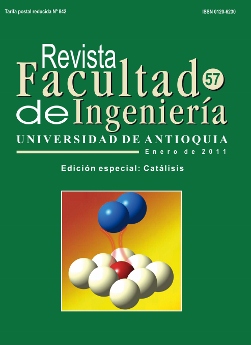Low temperature catalytic adsorption of NO over activated carbon honeycomb (ACH) monoliths
DOI:
https://doi.org/10.17533/udea.redin.14646Keywords:
catalyst, adsorption, activated carbon, tars, honeycomb monolithAbstract
An activated carbon honeycomb (ACH) monolith was developed for the adsorption of NO at 30ºC. For ACH monoliths preparation carboxymethylcellulose (CMC) and coal tar pitch were used as binder and co-binder, respectively. The effects of the addition of O2 and the presence of copper as catalyst were studied. For the Cu-impregnated activated carbon monolith samples, the presence of O2 favored NO adsorption by increasing the breakthrough time and the adsorption capacity.
Downloads
References
E. I. Administration. Annual Energy Outlook. 2009. United States Government: Washington DC. pp. 9-11.
W. H. Organization. The World Health Report. 2007. World Health Organization: Geneva( Switzerland). pp. 31-32.
J. L. Williams. “Monolith structures, materials, properties and uses”. Catalysis Today Vol. 69. 2001. pp. 3-9. DOI: https://doi.org/10.1016/S0920-5861(01)00348-0
K. P. Gadkaree, J. F. Mach. “Method of making activated carbon honeycombs having vaying adsorption capacities”. United States Patent 5510063. New York. 1996. pp. 1-10.
J. M. Gatica. J. M. Rodriguez-Izquierdo, D. Sánchez, T. Chafik, S. Harti, H. Zaitan, H. Vidal. “Originally prepared carbon-based honeycomb monoliths with potential application as VOCs adsorbents”. C.R. Chimie. Vol. 9. 2006. pp. 1215-1220. DOI: https://doi.org/10.1016/j.crci.2006.02.002
T. Vergunst. M. J. G. Linders, F. Kapteijn, J. Moulijn, “Carbon-based monolithic structures”. Catalysis Reviews. Vol. 42. 2001. pp. 291-314. DOI: https://doi.org/10.1081/CR-100107479
A. Tomita. “Suppression of nitrogen oxides emission by carbonaceous reductants”. Fuel Processing Technology, 2001. Vol. 71. pp. 53-70. DOI: https://doi.org/10.1016/S0378-3820(01)00136-9
V. I. Pârvulescu, S. Bogoshian, V. Pârvulescu, S. M. Jung, P. Grange. “Selective catalytic reduction of NO with NH3 over mesoporous V2O5-TiO2-SiO2 catalysts”. Journal of Catalysis. Vol. 217. 2003. pp. 172-185. DOI: https://doi.org/10.1016/S0021-9517(03)00028-9
P. Nikolov, M. Khristova, D. Mehandjiev. “Lowtemperature NO removal over copper-containing activated carbon”. Colloids and Surfaces A: Physicochemical and Engineering Aspects. Vol. 295. 2007. pp. 239-245. DOI: https://doi.org/10.1016/j.colsurfa.2006.09.004
M. Bishop, D. L. Ward. “The direct determination of mineral matter in coal”. Fuel. Vol. 37. 1958. pp. 191- 199.
D. López, R. Buitrago, A. Sepúlveda Escribano, F. Rodríguez Reinoso, F. Mondragón. “Low Temperature Catalytic Adsorption of NO on Activated Carbon Materials”. Langmuir. Vol. 23: 2007. pp. 12131- 12137. DOI: https://doi.org/10.1021/la701501q
R. Buitrago. Adsorción Catalítica Simultánea de SO2 y NO a Baja Temperatura en Carbones Activados. Instituto de Química. 2007. Universidad de Antioquia. Medellín. p. 82.
R. Q. Long, R.T. Yang. “Carbon Nanotubes as a Superior Sorbent for Nitrogen Oxides”. Industrial & Engineering Chemistry Research. Vol. 40. 2001. pp. 4288-4291. DOI: https://doi.org/10.1021/ie000976k
J. Zawadzki, M. Wisniewski, K. Skowronska. “Heterogeneous reactions of NO2 and NO-O2 on the surface of carbons”. Carbon. Vol. 41. 2003. pp. 235- 246. DOI: https://doi.org/10.1016/S0008-6223(02)00281-6
J. Zawadzki, M. Wisniewski. “An infrared study of the behavior of SO2 and NOx over carbon and carbonsupported catalysts”. Catalysis Today. Vol. 119. 2007. p. 213-218. DOI: https://doi.org/10.1016/j.cattod.2006.08.037
O. Byl, P. Kondratyuk, J. T. Yates. “Adsorption and Dimerization of NO Inside Single-Walled Carbon Nanotubes: An Infrared Spectroscopic Study”. The Journal of Physical Chemistry B. Vol. 107. 2003. pp. 4277-4279. DOI: https://doi.org/10.1021/jp022565i
P. García, F. Coloma, C. Salinas, F. Mondragón. “Nitrogen complexes formation during NO-C reaction at low temperature in presence of O2 and H2O”. Fuel Processing Technology. Vol. 77-78. 2002. pp. 255-259. DOI: https://doi.org/10.1016/S0378-3820(02)00014-0
M. J. Illán-Gómez, E. Raymundo-Piñero, A. Linares- Solano, C. Salinas. “Catalytic NOx reduction by carbon supporting metals”. Applied Catalysis B: Environmental. Vol. 20. 1999. p. 267-275. DOI: https://doi.org/10.1016/S0926-3373(98)00119-2
W. Klose, S. Rincón. “Adsorption and reaction of NO on activated carbon in the presence of oxygen and water vapour”. Fuel. Vol. 86. 2007. pp. 203-209. DOI: https://doi.org/10.1016/j.fuel.2006.06.017
Z. H. Zhu, J. Finnerty, G. Q. Lu, R.T. Yang. “Opposite Roles of O2 in NO-and N2O-Carbon Reactions: An Ab Initio Study”. Journal of Physical Chemistry B. Vol. 105. 2001.pp. 821-830. DOI: https://doi.org/10.1021/jp003036m
W. J. Zhang, S. Rabiei, A. Bagreev, M.S. Zhuang, F. Rasouli. “Study of NO adsorption on activated carbons”. Applied Catalysis B: Environmental. Vol. 83. 2008. pp. 63-71. DOI: https://doi.org/10.1016/j.apcatb.2008.02.003
Y. Kong, C.Y. Cha. “NOx adsorption on char in presence of oxygen and moisture”. Carbon. Vol. 34. 1996. pp. 1027-1033. DOI: https://doi.org/10.1016/0008-6223(96)00050-4
Downloads
Published
How to Cite
Issue
Section
License
Copyright (c) 2018 Revista Facultad de Ingeniería

This work is licensed under a Creative Commons Attribution-NonCommercial-ShareAlike 4.0 International License.
Revista Facultad de Ingeniería, Universidad de Antioquia is licensed under the Creative Commons Attribution BY-NC-SA 4.0 license. https://creativecommons.org/licenses/by-nc-sa/4.0/deed.en
You are free to:
Share — copy and redistribute the material in any medium or format
Adapt — remix, transform, and build upon the material
Under the following terms:
Attribution — You must give appropriate credit, provide a link to the license, and indicate if changes were made. You may do so in any reasonable manner, but not in any way that suggests the licensor endorses you or your use.
NonCommercial — You may not use the material for commercial purposes.
ShareAlike — If you remix, transform, or build upon the material, you must distribute your contributions under the same license as the original.
The material published in the journal can be distributed, copied and exhibited by third parties if the respective credits are given to the journal. No commercial benefit can be obtained and derivative works must be under the same license terms as the original work.










 Twitter
Twitter